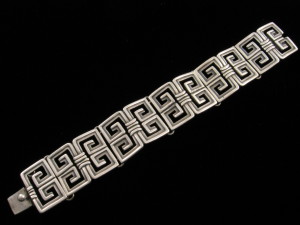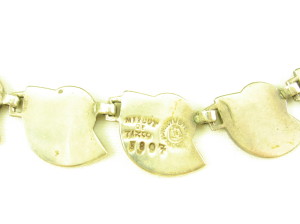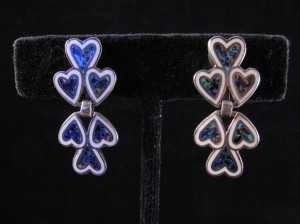
Margot van Voorhies Carr, known as “Margot de Taxco” was one of the great designers of Mexican jewelry in the mid-20th century. After moving to Mexico in 1937 she married Antonio Castillo who was working for William Spratling. While still working for Spratling Antonio produced and sold jewelry designed by Margot; because it sold well, Antonio, Margot and his brothers and cousins established “Los Castillo” in 1939 with Margot as principal designer.
After divorcing Antonio Castillo Margot opened “Margot de Taxco” in 1948. According to Penny Morrill and Carole Berk in “Mexican Silver”, Margot designed everything that her company produced and had book of instructions and drawings for each piece of jewelry detailing their construction and finishing.



Though her taller (workshop) also produced stunning repousse silver, she is best known for her champleve enamel work. Champleve enamel is an enameling technique in which troughs or cells are carved, etched, die struck, or cast into the surface and filled with vitreous enamel. It is similar in appearance to cloisonné enamel however in cloisonné the cells are created by soldering metal strips to a base to create the cells. In the case of Margot’s jewelry the designs were die-struck. Dies were created to stamp the designs out of silver and the die-making was a critical and detailed process of its own.


Margo’s designs bear the influences of pre-Columbian motifs, the Art Deco style, and Japanese Art (which can especially be seen in her use of fish and wave motifs).

Her design and marketing philosophy were spelled out on her business card which read: “As the stars are to the Night, so are the Jewels to the Woman”.
Many silversmiths who went on to open their own tallers worked for Margot including Sigi Pineda, the most well-known, who worked for her four years. Other silversmiths who worked for Margot, whose work is starting to be better-known, include Melecio Rodriquez and Miguel Melendez.
A fire in 1960 forced Margot to move her taller and it appears that she began to have financial difficulties after this disaster. Although continuing in business until the mid-70’s, her business was eventually taken over by the government to pay her debts. Margot gave her molds and dies to her silversmiths to pay her debts to them and, as a result, work is still being produced from Margot’s designs.

Follow

Hi Lisa,
I have a question I hope you can answer, I have the modern dots black and silver enamel necklace/choker. it has all the correct marks but it appears that I can not see the de in Margot de Taxco. it has the eagle mark with number 16 and everything else is correct. it is circa 1955 from what I can find. Was that ever an issue with her jewelry?
Hi Martha,
Thanks for getting in touch. I’m not aware of the “de” being missing as being a problem with Margot’s jewelry, but I’ve also not heard about her jewelry getting faked. So it’s probably OK.
Lisa
Other than the obvious hallmark, are there any other hallmarks that would identify her work? I read that a letter V inside a C was another of her hallmarks. How would you identify her designs while working with Los Castillos?
Hi JoAnn,
I’d recommend the Margot de Taxco monograph for trying to determine her work with Los Castillo. One clue would be Castillo work that doesn’t have the Mexican eagle assay mark, since the assay mark came into use in 1948, after Margot had left the Castillos. Of course, they may have continued to use her designs after she left, so it’s not an absolute determinant.
I’ve never seen a reliable source that shows her maker’s mark as being a V inside a C.
Best,
Lisa
I appreciate your help.